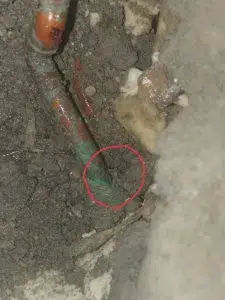How To Dry Out Floor After Leak
Suffering a water leak or water leaks in your property can be a real nightmare for homeowners; from clean up, the cost of finding the leak, and the repair. A seemingly small leak can come with a host of issues and water damage which are tricky to resolve.
One of the most frustrating issues is when concrete floors are damaged because of a water leak; these tend to be the foundations of many rooms and spaces, and so need to be completely dried and thoroughly aired before any further repairs can be made.
Fortunately for you, our Leak Detection service does not stop there, we offer expert advice regarding drying your property – our experienced team also knows a thing or two about drying concrete floors & walls after flooding or a water leak.

The Basics Of Drying Your Home Out After A Leak…
There are two main areas of focus when you are trying to dry up after a water leak: remove the flooding, and ensure that you get the walls, subfloor and floor surface dry as soon as possible. Standing water causes damage by its very presence, and so needs to be cleared out as soon as it is safe to do so.
Many homeowners make a rookie mistake: they can no longer see any water, and so they assume that flooring is dry after leaks. They then assume they can start the repairs, risking damp, mold and mildew becoming locked in once the new surfaces are laid – this, in turn, can cause an even more expensive headache down the line.
Getting concrete floors completely dry is the key to avoiding this issue;
Remove the Water
As we mentioned, the first priority is to remove as much excess water as possible, via mopping, draining or pumping. This helps to minimise the damage, and allows the drying process to occur more quickly.
Remove Floor Coverings
Most concrete floors are covered with underlay and carpet or wooden flooring. These will need to be removed in order to dry the concrete slab base. Even the best carpet cleaners are unable save carpets following water damage caused by a leak, although the cost of replacement will usually be covered by your house insurance. Wood floor is again usually to badly water damaged to be used again, this again is usually covered by your trace and access policy.
Allow Air To Circulate
Once you have removed all of the water, the next stage is to air out the room completely. The easiest – and cheapest – way to achieve this is to open as many windows as possible, allowing fresh air to circulate and remove moisture from the room. Adequate ventilation seriously speeds up the natural drying process, allowing you to go in with tools to speed up the process.
Use a dehumidifier
Once the windows are open and the fresh air is doing its thing, you can use dehumidifiers or fans to speed up the drying process. A dehumidifier is an essential tool since it removes the humidity and moisture from the air, allowing the floor beneath to dry more quickly. Drying the floor thoroughly reduces the risk of damp or mould developing. If the flood or leak was serious, always make sure that you have had the electrics checked by an electrician before plugging anything in.
Will a dehumidifier dry a wet floor?
A dehumidifier removes moisture from the air, which can help reduce humidity levels in a room. However, if a floor is wet, standing water on the surface likely needs to be removed first.
The most effective way to dry a wet floor is to first remove any excess water with a mop or wet vacuum. Then, use fans or other drying equipment to circulate air and speed up the evaporation process.
Once the excess water is removed and the air is circulating, a dehumidifier can help reduce humidity levels in the room and prevent moisture from being absorbed back into the floor.
In summary, while a dehumidifier can help dry a wet floor, there are more efficient and effective methods on its own. It’s essential to remove excess water and use fans or other drying equipment first before using a dehumidifier to prevent moisture from being absorbed back into the floor.
How long to dry out concrete floor after leak?
We mentioned above that a dehumidifier can be an excellent tool to help speed up the drying process, especially when a concrete slab floor is involved.
It is important to note, however, that the whole process will still take time, and rushing it will lead to its own issues.
Depending on the extent and nature of the damage, it may take anything from two days to a number of weeks to completely dry out the damage done by a flood or leak.
The goal is to ensure that the humidity levels in the air are kept below 50% – this is the stage at which moisture is effectively pulled from the air, and mould growth is discouraged.
While it can be tempting to cut the drying routine early, as it appears that everything is dry, you need to ensure that all surfaces are completely bone dry before you proceed with any restoration, redecoration or repair of flooring.
Taking the time to ensure that the job is done properly now may seem arduous, but it will help to keep your floor in good condition, offering a stable base to work fromyou get the floor
Call our friendly team on 0800 731 3843 if you think you have a water leak under your floor.









